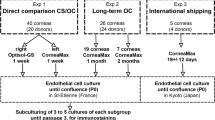Abstract
Background: To evaluate the ability of different commercially available cell culture media to induce proliferation and morphological changes in primary cultures of human corneal endothelial cells (HCEC). This screening model was used in an attempt to establish a rational basis for the development of well-defined, serum-free preservation media for long-term organ culture of human donor corneas. Methods: A total of 11 different culture media enriched with 0%, 2%, 5%, and 10% fetal calf serum (FCS) were compared. The test media were divided into three groups: Group 1: Media based on minimal essential medium (MEM), currently used for long-term corneal organ culture in European eye banks; Group 2: F99-based media, enriched for growth of corneal endothelial cells at serum-reduced conditions; and Group 3: Media designed for growth of special cell types or for short-term corneal organ culture. The growth-promoting capacity of each test medium was quantified using an HCEC proliferation assay, whereas changes in cell morphology were evaluated by phase-contrast microscopy. Results: The morphological characteristics of HCEC were best maintained in the group of F99-based media, which also induced the highest level of cell proliferation under serum-reduced conditions. Specifically, the medium F99-Sr (F99 enriched with ascorbic acid, insulin, bFGF, transferrin, selenium, and lipids) induced a two- to three-fold higher HCEC density at both 0% and 2% FCS when compared to all other test media, and it also maintained the most endothelial cell-like morphology. Also, at higher serum concentrations (5% and 10% FCS), the cell growth was most prominent in F99-Sr, as well as in the medium SFM that originally was designed for serum-free growth of vascular endothelial cells. Conclusion: This study suggests that the media F99-Sr and SFM should be further tested and refined as potential new storage solutions for long-term corneal organ culture at physiological temperatures.
Similar content being viewed by others
Author information
Authors and Affiliations
Additional information
Electronic Publication
Rights and permissions
About this article
Cite this article
Møller-Pedersen, T., Hartmann, U., Ehlers, N. et al. Evaluation of potential organ culture media for eye banking using a human corneal endothelial cell growth assay. Graefe's Arch Clin Exp Ophthalmol 239, 778–782 (2001). https://doi.org/10.1007/s004170100354
Received:
Accepted:
Published:
Issue Date:
DOI: https://doi.org/10.1007/s004170100354




